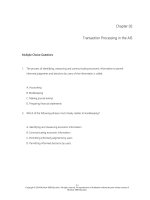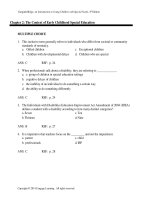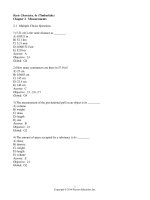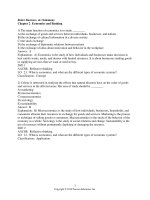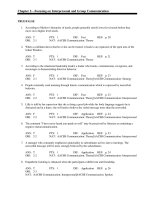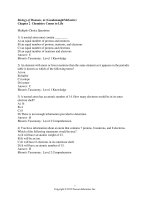Cultural anthropology canadian 4th edition haviland test bank
Bạn đang xem bản rút gọn của tài liệu. Xem và tải ngay bản đầy đủ của tài liệu tại đây (198.39 KB, 20 trang )
Chapter 2 The Nature of Culture
MULTIPLE CHOICE
1. Which of the following is included in Edward B. Tylor’s 1871 definition of culture?
a. human genetic variation
b. knowledge, belief, and morals
c. inherited characteristics
d. history, magic and legends
ANS: B
BLM: REM
PTS: 1
DIF: Average
REF: 30
2. How has today’s definition of culture changed since the 19th century?
a. Culture now includes abstract values and beliefs.
b. Culture is now seen as real rather than ideal.
c. The term “culture” has been replaced by “society.”
d. Culture is defined today as objects rather than ideas.
ANS: A
BLM: REM
PTS: 1
DIF: Average
REF: 30
3. What is a typical characteristic of most people who share the same culture?
a. They depend on one another for survival.
b. They can interpret and predict one another’s actions.
c. They inhabit the same territory.
d. They behave in an identical manner.
ANS: B
BLM: HO
PTS: 1
DIF: Average
REF: 30
4. In which circumstances are anthropologists likely to experience the most culture shock?
a. when they have just arrived in an unfamiliar culture
b. when they do fieldwork in a culture where men are dominant
c. when they do fieldwork in a pluralistic society
d. when they do fieldwork in post-industrial societies
ANS: A
BLM: HO
PTS: 1
DIF: Average
Copyright © 2013 Nelson Education
REF: 31
2-1
Chapter 2 The Nature of Culture
5. Which of the following statements about society and culture is correct?
a. Culture involves our understanding of belief and behavior while society just
reflects current behavior.
b. Culture is something portable, a society exists in a fixed place.
c. Culture describes temporary expressions of belief while society is permanent.
d. Sociologists are interested in society while anthropologists are interested in
culture.
ANS: B
BLM: REM
PTS: 1
DIF: Average
REF: 31
6. Which of the following is an anthropological definition of social structure?
a. a group of people living in the same geographical region
b. the buildings, roads, and facilities that allow people to interact
c. the relationships among groups that hold a community together
d. the family, including ancestors
ANS: C
BLM: REM
PTS: 1
DIF: Average
REF: 31
7. When Annette Weiner began fieldwork in the Trobriand Islands, what did she have to do to
understand the cultural meanings of Trobriand society?
a. let go of her own assumptions about the meanings of work, family, and power
b. recall everything she knew about how the people of Papua New Guinea behaved
c. discard everything she had learned from reading the works of Malinowski
d. go through the rituals of womanhood and become initiated along with local women
ANS: A
BLM: REM
PTS: 1
DIF: Average
REF: 32–33
8. What did Annette Weiner find when she went to the Trobriand Islands 60 years after
Malinowski?
a. The culture had changed so much that it was almost unrecognizable.
b. Malinowski’s views of wealth, political power, and descent were largely malecentred.
c. Malinowski had attributed more power to women than they actually held.
d. Women played no role in producing wealth.
ANS: B
BLM: REM
PTS: 1
DIF: Average
Copyright © 2013 Nelson Education
REF: 32–33
2-2
Chapter 2 The Nature of Culture
9. What conclusion did Annette Weiner come to in her study of the role and status of men in the
Trobriand Islands?
a. Trobriand men had no important role in procreation.
b. Trobriand men were dependent on women’s activities to enhance their status.
c. Trobriand husbands must fight to the death with their brothers-in-law in defence of
honour.
d. Trobriand men do not have satisfactory marital relationships with their wives.
ANS: B
BLM: REM
PTS: 1
DIF: Challenging REF: 32–33
10. Annette Weiner encountered “discordant realities” between her research findings from the
Trobriand Islands and the findings of Malinowski 60 years earlier. What did this indicate,
according to her?
a. She had been “overinfluenced” by the work of Malinowski.
b. It was her responsibility to contradict Malinowski’s findings because he was her
theoretical opponent.
c. The differences between her analyses and Malinowski’s reflected historical shifts
in anthropological perspectives and knowledge.
d. Malinowski’s interpretations of his data were mistaken because they were too
male-centred.
ANS: C
BLM: REM
PTS: 1
DIF: Challenging REF: 32–33
11. Some special interest groups, such as skateboarders and animal rights advocates, function
according to their own standards of behaviour as well as the standards of the larger society. What
term do anthropologists use to refer to these groups?
a. subversives
b. fringe groups
c. noncultural social units
d. subcultures
ANS: D
BLM: REM
PTS: 1
DIF: Easy
REF: 34
12. Which of the following is NOT a characteristic of Hutterite colonies in Western Canada?
a. The colonies are stratified, based on age.
b. The colonies are stratified based on gender.
c. The colonies are polygamous, with most men having more than one wife.
d. Young people are baptized in their early to mid-twenties.
ANS: C
BLM: REM
PTS: 1
DIF: Average
Copyright © 2013 Nelson Education
REF: 35
2-3
Chapter 2 The Nature of Culture
13. Which characteristic of Hutterites is an example of a subcultural variation?
a. They dress distinctively, hold common beliefs, and live in self-sufficient, closed
communities.
b. They do not share the Canadian values of thrift, hard work, independence, and
close family ties.
c. They do not pay taxes and own little communal property.
d. They are totally removed from all social, economic, and educational aspects of
Canadian society.
ANS: A
BLM: REM
PTS: 1
DIF: Average
REF: 35
14. What is the reason why the Hutterites are tolerated by Canadian society?
a. They are completely assimilated.
b. They have no significant contact with other Canadians.
c. They have no economic power.
d. They are descended from light-skinned Europeans.
ANS: D
BLM: REM
PTS: 1
DIF: Average
REF: 35
15. Why were the Acadians of New Brunswick and Nova Scotia expelled by the British
government?
a. They refused to pay taxes.
b. They refused to sign an oath of allegiance to the Crown.
c. They refused to return to France.
d. They refused to cede their land to the British colonists.
ANS: B
BLM: REM
PTS: 1
DIF: Average
REF: 35
16. What is the greatest threat to Acadian solidarity and cultural integrity in 21st-century Canada?
a. economic problems stemming from loss of fertile land
b. the loss of the Acadian language
c. discrimination from lighter-skinned Canadians
d. intermarriage with non-Acadians
ANS: A
BLM: REM
PTS: 1
DIF: Average
Copyright © 2013 Nelson Education
REF: 35
2-4
Chapter 2 The Nature of Culture
17. Which statement most accurately describes the social position of First Nations people in Canada
in relation to the Canadian population as a whole?
a. They are non-Canadian citizens.
b. They are diverse and distinct subcultures.
c. They are distinct cultures within Canadian society.
d. They are incompletely integrated communities.
ANS: C
BLM: REM
PTS: 1
DIF: Average
REF: 35
18. What does Lauraine Leblanc contend with regard to the participation of young females in punk
subcultures, according to her study of the subject?
a. It’s evidence of female passivity.
b. It’s a way of resisting traditional gender norms of mainstream society.
c. It fades quickly when the girls realize they have no voice in the groups.
d. It prevents them from asserting their independence.
ANS: B
BLM: REM
PTS: 1
DIF: Average
REF: 36
19. “Canada is a cultural mosaic.” Which statement best reflects what that means?
a. Canadian society is homogeneous.
b. Canadian society is brittle.
c. Canadian society is distinct.
d. Canadian society is pluralistic.
ANS: D
BLM: HO
PTS: 1
DIF: Easy
REF: 36
20. Which term refers to powerful indicators that identify individuals as belonging to a particular
ethnic group and that set them apart from other ethnic groups?
a. patriotic symbols
b. ethnic boundary markers
c. ethnic labels
d. customary heritage signals
ANS: B
BLM: REM
PTS: 1
DIF: Average
REF: 36
21. What is the term used to refer to the descendants of French and Scottish voyageurs and First
Nations women?
a. Indian
b. Métis
c. Aboriginal
d. half-French or half-Scot, depending on the father’s ethnic background
ANS: B
BLM: REM
PTS: 1
DIF: Average
Copyright © 2013 Nelson Education
REF: 37
2-5
Chapter 2 The Nature of Culture
22. A proposal to allow sharia law in Ontario was rejected. What was the main objection that led to
its rejection?
a. Sharia law is practiced in Iran and has no legal status in Canada.
b. Many women feared that imposition of sharia law would threaten the equality of
Muslim women.
c. Sharia law was not understood by Ontario’s Muslims.
d. Sharia law was likely to exclude men in divorce and child custody cases.
ANS: B
BLM: HO
PTS: 1
DIF: Average
REF: 37
23. What is the main reason for family stress among Pakistani families who have newly immigrated
to Canada?
a. joblessness and underemployment
b. lack of housing and access to familiar foods
c. cultural clashes with Canadian-born children
d. lack of places of worship
ANS: A
BLM: REM
PTS: 1
DIF: Easy
REF: 38
24. According to the text, what finding did Statistics Canada report in 2004?
a. The family incomes of immigrants were considerably lower than for Canadian
citizens.
b. Immigrants applying for jobs were more likely to be hired than Canadian citizens.
c. Immigrant women are reluctant to take English or French language courses, even
when offered low-cost childcare.
d. Qualified immigrants have an easy time finding work as engineers.
ANS: A
BLM: REM
PTS: 1
DIF: Easy
REF: 38
25. What is the term for the process by which a society’s shared values and beliefs are transmitted
from one generation to the next?
a. adaptation
b. pluralism
c. enculturation
d. social education
ANS: C
BLM: REM
PTS: 1
DIF: Average
Copyright © 2013 Nelson Education
REF: 39
2-6
Chapter 2 The Nature of Culture
26. From an anthropological perspective, how would the role that kindergarten plays in the lives of
young children in Canada best be described?
a. It is an integrative force.
b. It is an enculturative force.
c. It is a pluralistic force.
d. It is a functional force.
ANS: B
BLM: HO
PTS: 1
DIF: Average
REF: 39
27. What does all human behaviour originate in, according to anthropologist Leslie White?
a. sexual drives
b. economic exchange
c. adherence to religion
d. the use of symbols
ANS: D
BLM: REM
PTS: 1
DIF: Average
REF: 39
28. What custom does marriage require among the Kapauku Papuans of New Guinea?
a. The bride’s family must pay a man to marry their daughter.
b. The bride must be captured from an enemy tribe.
c. The groom must pay a bride price.
d. Several brothers must agree to marry the same woman.
ANS: C
BLM: REM
PTS: 1
DIF: Average
REF: 40
29. Which of the following conditions led to the practice of polygyny among the Kapauku Papuans
of New Guinea?
a. There was a surplus of adult women.
b. There was a surplus of adult men.
c. The rules of war permitted the killing of women but not men.
d. Sexual promiscuity was frequent.
ANS: A
BLM: REM
PTS: 1
DIF: Average
Copyright © 2013 Nelson Education
REF: 40
2-7
Chapter 2 The Nature of Culture
30. Among the Kapauku Papuans of New Guinea, attempts to eliminate warfare would affect the sex
ratio and the practice of polygyny. This would in turn affect the economy, since women raise
pigs, and the more wives a man has, the more pigs he has and the wealthier he is. What do these
complex relationships tell us about culture?
a. It is materialistic.
b. It is integrated.
c. It is pluralistic.
d. It is logical.
ANS: B
BLM: REM
PTS: 1
DIF: Average
REF: 40
31. Some people in Western cultures hope to eliminate practices such as polygyny in other cultures.
If they took a course in cultural anthropology, they might realize that culture is an integrated and
interrelated whole. What does this mean?
a. People of the same ethnic groups get along well together.
b. Subcultural variation cannot be tolerated.
c. Altering one aspect of a culture can have consequences for other aspects of the
culture.
d. Indigenous people’s cultures do not change internally.
ANS: C
BLM: HO
PTS: 1
DIF: Challenging REF: 42
32. Which of the following is typically associated with an interest in popular culture?
a. Fleeting interest in the lives of ordinary people.
b. A focus on superficial social attitudes.
c. Lower-class status.
d. A lack of redeeming cultural values.
ANS: C
BLM: REM
PTS: 1
DIF: Average
REF: 41
33. What has recently been identified as an imposed factor that led to serious individual and cultural
damage for First Nations people?
a. involvement in the commercial fur trade
b. relocation of First Nations people onto reserves
c. the adoption of European-style agriculture
d. residential schools
ANS: D
BLM: REM
PTS: 1
DIF: Average
Copyright © 2013 Nelson Education
REF: 43
2-8
Chapter 2 The Nature of Culture
34. What are you guilty of if you say, “My people’s way of life is superior to your people’s way of
life”?
a. cultural relativism
b. racism
c. ethnocentrism
d. egocentrism
ANS: C
BLM: HO
PTS: 1
DIF: Easy
REF: 44
35. Which of the following problems would NOT be generated by extreme ethnocentrism?
a. reluctance to question the customs and beliefs of our own society
b. jealousy on the part of people who are not members of one’s own society
c. prejudice and racism
d. ethnic conflict
ANS: B
BLM: HO
PTS: 1
DIF: Average
REF: 44
36. Because societies are unique, each can be evaluated only according to its own standards and
values. Which term refers to this point of view?
a. ethnocentrism
b. cultural relativism
c. pluralism
d. adaptation
ANS: B
BLM: REM
PTS: 1
DIF: Average
REF: 45
37. What do anthropologists maintain is their mission when doing fieldwork?
a. to change their own values and beliefs to conform to those of the culture they are
studying
b. to transform cultures that are dysfunctional or out of control
c. to avoid forming any opinions about the values and beliefs of other cultures
d. to determine the reasons for certain behaviour patterns in the culture being studied
ANS: D
BLM: HO
PTS: 1
DIF: Average
Copyright © 2013 Nelson Education
REF: 45
2-9
Chapter 2 The Nature of Culture
38. Why do anthropologists study Aztec human sacrifice?
a. to more easily condemn it as a barbaric practice
b. to understand how it reassured the people that their society was functioning
properly
c. to argue that human sacrifice is acceptable in certain circumstances
d. to differentiate it from the death penalty as applied in other countries today
ANS: B
BLM: REM
PTS: 1
DIF: Average
REF: 44
39. According to anthropologists, which of the following can be in conflict with the ideal of cultural
relativism?
a. human rights
b. anthropological professionalism
c. the maintenance of objectivity
d. the promotion of democracy
ANS: A
BLM: HO
PTS: 1
DIF: Challenging REF: 45
40. Goldschmidt suggests that it is possible to make judgments about which cultures are more
successful than others. How does he suggest this can be done?
a. by looking at which cultures control the most fertile land
b. by considering which cultures last the longest
c. by how well a given culture satisfies people’s physical and psychological needs
d. by how effectively a given culture controls behaviour and immorality
ANS: C
BLM: REM
PTS: 1
DIF: Challenging REF: 45
41. What must any culture do to ensure its ongoing existence?
a. institute a democratic means of choosing its leaders
b. provide a sustainable means of adaptation to the ecosystem
c. maintain a centralized system to detect crime and delinquency
d. produce a written language to pass on all accumulated knowledge
ANS: B
BLM: REM
PTS: 1
DIF: Challenging REF: 46
Copyright © 2013 Nelson Education
2-10
Chapter 2 The Nature of Culture
42. How did applied anthropologist George Esber help the Tonto Apache and the architect designing
new housing for them?
a. He showed them how to make simple mud bricks.
b. Using observation and interviews, he obtained data that revealed how their social
patterns of behaviour required certain design requirements.
c. He arranged for the tribe to apply for federal funding.
d. Through careful observation, he determined the design that would meet their social
needs.
ANS: B
BLM: REM
PTS: 1
DIF: Average
REF: 34
43. What aspect of Apache social interaction indicated that they required a large, open living space?
a. They like to ease into social interaction slowly, maintaining their personal space
and a full view of each other.
b. Social interaction is accompanied by ceremonial dancing that sometimes involves
large groups.
c. They have no concept of personal space and only socialize in large groups.
d. Walls symbolize secrecy for them, as they traditionally lived in open wigwams.
ANS: A
BLM: REM
PTS: 1
DIF: Average
REF: 34
44. Why do you think that Apache etiquette requires cooking and dining space that is NOT separate
from other living space?
a. They eat their meals directly from cooking pots on the stove as if they were on an
open fire.
b. Cooks might feel excluded from social interaction if confined to a separate kitchen.
c. A good host must offer food to guests before any social interaction takes place.
d. All guests must bring a food offering to be shared socially with the host.
ANS: C
BLM: REM
PTS: 1
DIF: Average
REF: 34
45. Why do the Roma (Gypsies) NOT have strong ties to a homeland, unlike so many other
immigrants?
a. They were subjected to genocide in 1456 in their homeland.
b. Their homeland was absorbed by the former Soviet Union in 1919.
c. They are not really a culture, society, or ethnicity and just move constantly.
d. They migrated away from their homeland about 1,000 years ago.
ANS: D
BLM: HO
PTS: 1
DIF: Average
Copyright © 2013 Nelson Education
REF: 36
2-11
Chapter 2 The Nature of Culture
46. What is one of the main factors that causes gender inequality for Portuguese immigrant women
to increase?
a. They are not recognized as legal adults under Portuguese law.
b. They lack valued work skills and therefore get classified as familial dependents of
their husbands when applying for immigration.
c. They have been targeted by the sex trade, immigration scams, and unqualified
male immigration consultants in the U.K. and Canada.
d. Portuguese culture is matriarchal in nature.
ANS: B
BLM: REM
PTS: 1
DIF: Average
REF: 38
47. What is the term for small subcultures that may emerge from particular aspects of popular
culture.
a. ethnicities
b. mini-cultures
c. micro-cultures
d. trend-cultures
ANS: C
BLM: REM
PTS: 1
DIF: Average
REF: 40
48. CASCA is a national organization that promotes anthropology in Canada. What are the three
main goals of this organization?
a. graduate anthropology programs, undergraduate anthropology programs, nonacademic anthropology
b. anti-racism, promoting evolutionary science, promoting multiculturalism
c. First Nations research, immigration research, subculture research
d. cultural anthropology, biological anthropology, linguistic anthropology
ANS: A
BLM: REM
PTS: 1
DIF: Challenging REF: 42
49. According to the International Centre for Prison Studies in the U.K., which nation has the highest
number of prison inmates per capita in the world?
a. China
b. Russia
c. Iran
d. U.S.A.
ANS: D
BLM: REM
PTS: 1
DIF: Average
Copyright © 2013 Nelson Education
REF: 45
2-12
Chapter 2 The Nature of Culture
50. Human sacrifice may be perceived as a negative aspect of Aztec culture. What are the most
rational reasons for its continuation?
a. It pleased the gods and contributed to the maintenance of the cosmic order.
b. It acted as a deterrent to disobedience and as a motivation to pay tribute (taxes).
c. It guaranteed the victim’s entry into heaven and afterlife rewards.
d. It ensured the safety and positive status of the victim’s family.
ANS: B
BLM: HO
PTS: 1
DIF: Challenging REF: 44
51. Using your knowledge of culture, which option best describes conditions that may contribute to
the highest levels of ethnocentrism and lowest levels of cultural relativism?
a. long-term political stability, monolingualism, religious homogeneity, and longterm geographic isolation
b. ethnic diversity, multilingualism, religious diversity, and wide geographic
distribution
c. patriarchal families, matrilineal political control, multiculturalism, and
ethnographic solidarity
d. advanced political evolution, complex language development, racial superiority,
and economic stability
ANS: A
BLM: HO
PTS: 1
DIF: Challenging REF: 44
52. Culture includes abstract values, beliefs, and perceptions of the world that lie behind people’s
behaviour. Which of the following options best corresponds to the understanding of culture we
get from chapter two of the textbook?
a. It is passed on biologically, learned through language, and its parts function as an
integrated whole.
b. It is shared, learned through language, and provides permanent fixed modes of
belief and behaviour.
c. It is shared, learned through language, and its parts function as an integrated
whole.
d. It is shared, learned through language, and it is organized on the basis of many
subcultures.
ANS: C
BLM: HO
PTS: 1
DIF: Challenging REF: 40
53. Which statement best characterizes popular culture in our society?
a. It is created by the entertainment industry.
b. It is a youth phenomenon.
c. It all originated from literature.
d. It is the music, dance, legends, food, games, and folk art of our everyday lives.
ANS: D
BLM: HO
PTS: 1
DIF: Average
Copyright © 2013 Nelson Education
REF: 40
2-13
Chapter 2 The Nature of Culture
54. Which option best describes the role of culture?
a. Culture sets limits of behaviour and guides it along predictable paths.
b. Culture sets limits of behaviour and but is often unpredictable.
c. Culture sets limits of behaviour but biology accounts for the content of behaviour.
d. Culture sets limits of behaviour and society sets the limits of belief.
ANS: A
BLM: REM
PTS: 1
DIF: Average
REF: 30
55. Reflecting on what you have learned about culture, which of the following statements best
expresses the role of culture in relation to the needs of individuals and the needs of society.
a. Culture must control the self-interest of individuals and the needs of society as a
whole.
b. Culture must strike a balance between the self-interest of individuals and the needs
of society as a whole.
c. Culture must promote the self-interest of individuals over the needs of society as a
whole.
d. Culture should not interfere in the self-interest of individuals or the needs of
society as a whole.
ANS: B
BLM: HO
PTS: 1
DIF: Average
REF: 29–30
56. Why is the notion of adaptation such a critical aspect of all human culture?
a. because we use adaptation to create new technology to better control our destiny
b. because our adaptation as primates has only involved culture
c. because every culture must subsist within, and adapt to, an ecosystem that can
support life in some sustainable manner
d. because every culture must actively alter an ecosystem to support life in some
sustainable manner
ANS: C
BLM: REM
PTS: 1
DIF: Average
Copyright © 2013 Nelson Education
REF: 42
2-14
Chapter 2 The Nature of Culture
TRUE/FALSE
1. A modern definition of culture emphasizes the values, beliefs, and rules that lie behind
behaviour, as well as observable behaviour itself.
ANS: T
PTS: 1
DIF: Average
REF: 30–31
2. Each culture in the world is unique, and all cultures display striking similarities to each other in
fulfilling the needs of their members.
ANS: T
PTS: 1
DIF: Average
REF: 30–31
3. Anthropologists in the field are unlikely to experience culture shock because they are taught the
strategies to avoid it.
ANS: F
PTS: 1
DIF: Average
REF: 31
4. To say that culture is shared means that all members of a society behave in the same way.
ANS: F
PTS: 1
DIF: Easy
REF: 30–31
5. The idea that culture is shared means that everyone in that culture plays the same roles.
ANS: F
PTS: 1
DIF: Easy
REF: 30–31
6. Annette Weiner maintains that the differences between her interpretations of Trobriand culture
and those of Bronislaw Malinowski simply illustrate historical developments in anthropological
knowledge and inquiry.
ANS: T
PTS: 1
DIF: Challenging REF: 32–33
7. Annette Weiner’s study of the Trobrianders basically replicated and validated Malinowski’s
original findings.
ANS: F
PTS: 1
DIF: Average
REF: 32–33
8. Annette Weiner agrees that ethnographic writing can never be more than a fictional account of
cultural behaviour.
ANS: F
PTS: 1
DIF: Average
Copyright © 2013 Nelson Education
REF: 32–33
2-15
Chapter 2 The Nature of Culture
9. The status and power of elderly people throughout the world shows little cultural variation.
ANS: F
PTS: 1
DIF: Average
REF: 34
10. The Muslim community of Montreal is unusual because it is comprised only of people from
Arab countries.
ANS: F
PTS: 1
DIF: Average
REF: 34
11. The term subculture refers to a weak, disorganized, and relatively unimportant culture.
ANS: F
PTS: 1
DIF: Average
REF: 34–35
12. Cross-cultural studies show that homicide rates mostly decline after the death penalty is
abolished.
ANS: T
PTS: 1
DIF: Average
REF: 44
13. Providing restitution to Chinese immigrants to Canada who had to pay a head tax was promoted
by Heritage Canada.
ANS: T
PTS: 1
DIF: Average
REF: 36–37
14. Hutterite colonies in Canada are stratified by age and gender.
ANS: T
PTS: 1
DIF: Average
REF: 35
15. Economic practices of Canadian Hutterites demonstrate that they do contribute positively to the
larger Canadian society.
ANS: T
PTS: 1
DIF: Challenging REF: 35
16. The Acadians who were allowed to return to Canada in 1764 were able to resume living and
working on their fertile farms, which had been held for them.
ANS: F
PTS: 1
DIF: Average
REF: 35
17. The greatest threat to Acadian solidarity and cultural integrity in the 21st century stems from
serious economic problems.
ANS: T
PTS: 1
DIF: Average
Copyright © 2013 Nelson Education
REF: 35
2-16
Chapter 2 The Nature of Culture
18. Canada is the only society in the world today that is a cultural mosaic.
ANS: F
PTS: 1
DIF: Challenging REF: 36
19. Punk subcultures tend to be female-dominated.
ANS: F
PTS: 1
DIF: Average
REF: 36
20. Regardless of their origins or current regional location, all Canadian speakers of French have a
strong interest in maintaining political independence from Canada.
ANS: F
PTS: 1
DIF: Average
REF: 37
21. Numerous studies by a variety of social scientists have clearly shown that the death penalty does
deter violent crime in the United States.
ANS: F
PTS: 1
DIF: Average
REF: 44
22. Gender discrimination is entrenched in Canada’s immigration policy.
ANS: T
PTS: 1
DIF: Average
REF: 38
23. Generational clashes do not appear to be a problem among immigrant families in Canada.
ANS: F
PTS: 1
DIF: Average
REF: 38
24. The most important symbolic aspect of culture is language.
ANS: T
PTS: 1
DIF: Average
REF: 39
25. Cattle herding is the mainstay around which all of Kapauku Papuan society revolves.
ANS: F
PTS: 1
DIF: Average
REF: 40
26. Polygyny is defined as the marriage of one man to more than one woman.
ANS: T
PTS: 1
DIF: Average
REF: 40
27. Both contemporary Islam and Christianity are religions that contain many elements of popular
culture.
ANS: T
PTS: 1
DIF: Average
Copyright © 2013 Nelson Education
REF: 41
2-17
Chapter 2 The Nature of Culture
28. The popular culture of Hippies that emerged in the 1970s had completely vanished by the end of
the 1980s.
ANS: F
PTS: 1
DIF: Average
REF: 40–41
29. Pastoral nomadic peoples of sub-Saharan Africa are a source of annoyance to postcolonial
governments in the region because they are difficult to control.
ANS: T
PTS: 1
DIF: Average
REF: 42
30. Attendance at residential schools for First Nations children was voluntary and a matter of choice
by their parents.
ANS: F
PTS: 1
DIF: Average
REF: 43–44
31. If a society is to survive, it must succeed in balancing the self-interest of its members against the
demands of the society as a whole.
ANS: T
PTS: 1
DIF: Average
REF: 43–44
ESSAY
1. To what extent is Canada a pluralistic/multicultural society? What problems are associated with
pluralism? How can these problems be resolved?
ANS: Answers will vary
PTS: 1
DIF: Challenging REF: 35–37
2. Using the Hutterites as an example of subcultural variation, discuss some of the factors that seem
to determine whether or not subcultural variation is tolerated by the larger culture. In your essay,
briefly compare the treatment of Hutterites in Canada with that of First Nations people, and
account for the differences.
ANS: Answers will vary
PTS: 1
DIF: Challenging REF: 34–37
3. What were Annette Weiner’s findings stemming from her study of the Trobrianders, and what
was the significance of the differences between her study and the research originally undertaken
by Bronislaw Malinowski?
ANS: Answers will vary
PTS: 1
DIF: Challenging REF: 32–33
Copyright © 2013 Nelson Education
2-18
Chapter 2 The Nature of Culture
4. Because of the male bias of his European culture, Bronislaw Malinowski’s pioneering study of
the Trobriand Islanders missed many important factors. Discuss the significant factors that were
overlooked due to male bias.
ANS:
Answers will vary
PTS: 1
DIF: Average
REF: 32–33
5. Identify and describe the function of at least three ethnic boundary markers. Give specific
examples.
ANS:
Answers will vary
PTS: 1
DIF: Challenging REF: 36
6. Identify and discuss three of the “daunting challenges” faced by both female and male
immigrants after their arrival in Canada.
ANS:
Answers will vary
PTS: 1
DIF: Challenging REF: 36–37
7. Popular culture has an overwhelming negative affect on its global consumers and will ultimately
result in the disappearance of traditional cultures and the rise of global homogenization. Do you
agree or disagree? Discuss your views and provide examples.
ANS:
Answers will vary
PTS: 1
DIF: Challenging REF: 40–41
8. Discuss the main factors contributing to disastrous droughts in the region of Africa just south of
the Sahara Desert, and comment on how these droughts are affecting pastoral nomadic peoples
of the region.
ANS:
Answers will vary
PTS: 1
DIF: Challenging REF: 42
Copyright © 2013 Nelson Education
2-19
Chapter 2 The Nature of Culture
9. Provide some examples from cultural anthropology to support the statement, “What is adaptive
in one context may be seriously maladaptive in another.”
ANS:
Answers will vary
PTS: 1
DIF: Average
REF: 41–45
10. Why have anthropologists adopted an approach of cultural relativism when they are engaged in
ethnographic research? What contemporary controversies have emerged regarding this approach,
and how can anthropologists reconcile cultural relativism with issues of human rights?
ANS:
Answers will vary
PTS: 1
DIF: Challenging REF: 45
11. Using specific examples from the text assess the value of anthropology and the work of two
anthropologists in promoting cultural tolerance in Canada.
ANS:
Answers will vary
PTS: 1
DIF: Average
REF: 30–45
Copyright © 2013 Nelson Education
2-20
